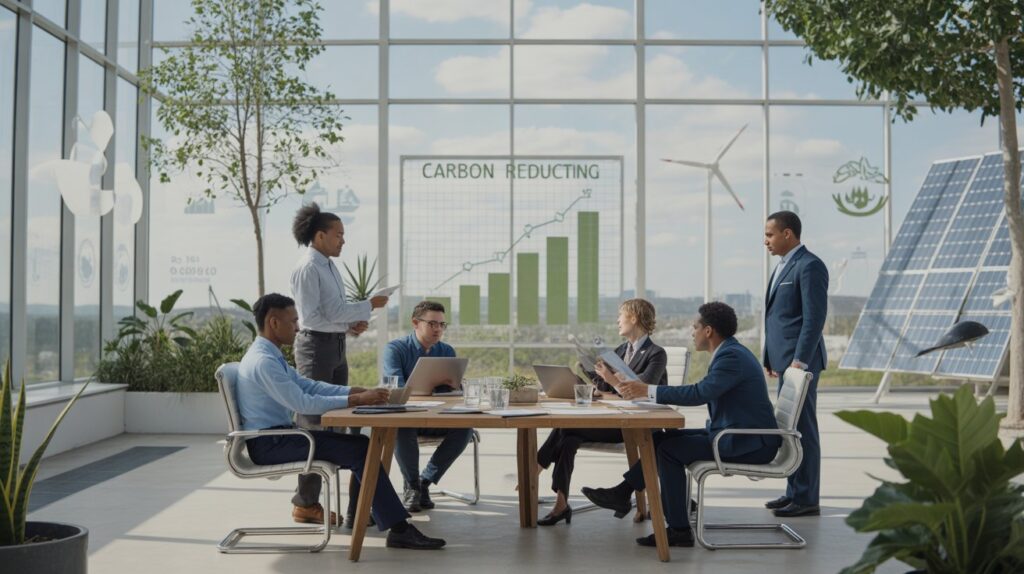Climate change is no longer a distant concern—it’s an urgent business issue. Investors, consumers, and regulators now expect companies of all sizes to act on their environmental impact. But knowing where to start can be challenging. How Businesses Can Reduce Their Carbon Footprint isn’t just a question of compliance; it’s an opportunity to cut costs, improve efficiency, and strengthen brand trust.
This comprehensive guide outlines 12 actionable steps that organizations can take to measure, manage, and meaningfully reduce their carbon emissions. Whether you run a small enterprise or a global corporation, these strategies will help you transition toward a low-carbon, resilient future.
Understanding Your Carbon Footprint
Before taking action, every business must first understand what a carbon footprint actually represents. A company’s carbon footprint is the total amount of greenhouse gases (GHGs) it emits, directly and indirectly, expressed as carbon dioxide equivalent (CO₂e). These emissions are grouped into three categories:
-
Scope 1: Direct emissions from sources your company owns or controls, such as company vehicles or on-site fuel combustion.
-
Scope 2: Indirect emissions from purchased electricity, heat, or steam.
-
Scope 3: All other indirect emissions across your value chain—suppliers, logistics, employee commuting, and product use.
For most organizations, Scope 3 makes up the largest portion of total emissions. That’s why accurate measurement is essential before any reduction strategy can succeed.
Measure Your Baseline
Measurement is the foundation of climate action. Conduct a full carbon audit using reputable frameworks such as the Greenhouse Gas (GHG) Protocol or ISO 14064. Start by gathering data from utility bills, travel logs, supplier invoices, and production records. Once you’ve identified your major emission sources, calculate your total footprint and set realistic reduction targets.
Tools like the UK government’s SME Climate Hub calculator or global platforms such as ClimatePartner and Planetly can help you quantify your emissions quickly and consistently.
Set Clear Reduction Targets
After measurement, establish specific, science-based targets. Align your goals with the Science-Based Targets initiative (SBTi) or national net-zero frameworks. Define short-term (1–3 years), medium-term (3–5 years), and long-term (10+ years) milestones. Publicly committing to measurable goals improves accountability and can enhance your company’s reputation with clients and investors.
Switch to Renewable Energy
Energy consumption is one of the largest contributors to a business’s carbon footprint. Transitioning to renewable energy sources—solar, wind, hydro, or certified green tariffs—can significantly reduce emissions. Many utility providers now offer renewable contracts that require minimal operational changes. For businesses with space, installing on-site solar panels can also deliver long-term savings and energy independence.
Beyond electricity, review heating and cooling systems. Replace gas boilers with heat pumps or other low-carbon alternatives where feasible.
Improve Energy Efficiency
Energy efficiency delivers one of the fastest returns on investment. Start with a simple energy audit of your premises:
-
Upgrade to LED lighting with motion sensors.
-
Install smart thermostats and optimize HVAC systems.
-
Switch off idle equipment or implement automatic shutdown settings.
-
Choose ENERGY STAR or equivalent energy-efficient appliances.
Even small behavioral changes—like turning off monitors at night—can save thousands of kilowatt-hours annually.
Rethink Business Travel and Commuting
The shift to digital collaboration has shown how much business travel can be reduced without harming productivity. Replace non-essential trips with virtual meetings and conferences. When travel is necessary, choose rail over air, encourage carpooling, and adopt low-emission vehicles.
To support employees, create a sustainable travel policy that promotes remote work, cycle-to-work schemes, and public transport incentives. These actions not only cut emissions but also improve work-life balance and employee satisfaction.
Green Your Supply Chain
For most companies, supply-chain emissions (Scope 3) represent over 70% of their total carbon footprint. Engaging suppliers is therefore crucial. Begin by mapping your supply chain to identify high-impact partners, then collaborate to reduce emissions collectively. Include environmental performance criteria in supplier contracts, prefer local vendors, and request sustainability certifications such as ISO 14001 or CarbonNeutral®.
Consider developing a supplier code of conduct that aligns with your sustainability values. Over time, this approach builds resilience and transparency across your value chain.
Optimize Logistics and Distribution
Transportation and logistics are major emission hotspots, especially for product-based businesses. Review shipping routes, packaging, and delivery frequency to identify efficiency gains:
-
Consolidate shipments and avoid partial loads.
-
Use electric or hybrid fleets for last-mile deliveries.
-
Minimize packaging weight and switch to recyclable materials.
-
Partner with logistics providers committed to carbon-neutral delivery options.
Even digital businesses can benefit by choosing cloud services powered by renewable data centers.
Reduce Waste and Promote Circularity
Waste reduction directly lowers both operational costs and emissions. Introduce recycling programs, minimize single-use materials, and donate or repurpose unused products. Apply the “Reduce, Reuse, Recycle” hierarchy across operations.
If your business manufactures goods, explore circular design principles—creating products that can be reused, repaired, or recycled at the end of life. Circularity reduces reliance on raw materials and demonstrates long-term environmental responsibility.
Address Your Digital Carbon Footprint
Many companies overlook the environmental impact of their digital infrastructure. Data storage, websites, and cloud computing consume significant energy. To reduce your digital carbon footprint:
-
Choose web hosts that run on renewable energy.
-
Optimize website images and code for faster load times.
-
Use content delivery networks (CDNs) to reduce server energy use.
-
Regularly delete unnecessary files and emails.
IT departments can also extend hardware lifespans through maintenance and responsible e-waste recycling programs.
Engage Employees in Sustainability
Your workforce plays a key role in achieving sustainability goals. Build awareness through training, internal campaigns, and clear communication about progress. Encourage teams to suggest innovative ideas for emission reduction—often, the best solutions come from employees closest to daily operations.
Create green teams or sustainability champions to maintain momentum. Recognize and reward contributions that align with environmental targets.
Offset What You Can’t Yet Eliminate
While reduction should always come first, some emissions are currently unavoidable. Carbon offsetting allows businesses to compensate for residual emissions by supporting verified projects that remove or prevent CO₂ elsewhere—such as reforestation, renewable-energy development, or methane capture.
Choose only verified carbon credits from recognized standards like Gold Standard or Verified Carbon Standard (VCS). Transparency about the amount offset and project type builds trust and credibility.
Monitor, Report, and Communicate Progress
Sustainability is a continuous journey, not a one-time project. Regularly track your performance against established targets and update stakeholders through annual sustainability reports. Reporting frameworks such as the Task Force on Climate-related Financial Disclosures (TCFD) or Global Reporting Initiative (GRI) can guide consistent, credible disclosures.
Publicly sharing results demonstrates accountability and can enhance your brand image. More importantly, it keeps the organization focused on continuous improvement.
Benefits of Reducing Your Carbon Footprint
Implementing these strategies delivers tangible advantages beyond environmental impact:
-
Cost savings: Reduced energy and resource consumption directly lower operational expenses.
-
Compliance and risk management: Staying ahead of regulation protects your business from future penalties.
-
Enhanced reputation: Sustainability credentials attract clients, investors, and talent.
-
Innovation and resilience: Transitioning to low-carbon models drives efficiency and long-term competitiveness.
Ultimately, sustainability is good business. It positions your company for growth in a market that increasingly values responsibility and transparency.
Real-World Example: The Office Retrofit Case
A mid-sized technology company conducted a baseline carbon audit and found that 60% of its emissions came from office energy use and commuting. After upgrading to LED lighting, adopting remote work policies, and purchasing renewable electricity, the company reduced annual emissions by 35% and energy costs by 28%.
This practical example illustrates how data-driven action can yield both environmental and financial returns.
FAQs
1. What is the first step in reducing a business’s carbon footprint?
Begin with a comprehensive measurement of your current emissions using tools aligned with the GHG Protocol. Knowing where emissions originate allows you to target the most impactful areas first.
2. How can small businesses make a difference?
Small businesses can act by switching to green energy, improving energy efficiency, and choosing sustainable suppliers. Collective action from SMEs has a powerful cumulative effect.
3. Are carbon offsets effective?
Offsets should supplement—not replace—direct reductions. When sourced from verified projects, they can effectively neutralize residual emissions while supporting global sustainability efforts.
4. How often should we report progress?
Annual reporting is recommended, but continuous monitoring ensures you stay on track. Share progress internally each quarter to maintain engagement and accountability.
5. Why is supply-chain engagement so important?
Because most emissions occur outside a company’s direct control, collaborating with suppliers can deliver the largest reduction potential. Sustainable procurement strengthens your entire value chain.
Conclusion
Reducing your company’s carbon footprint is both a moral imperative and a strategic advantage. By measuring emissions, setting clear goals, switching to renewables, optimizing operations, and engaging employees, any organization can make measurable progress toward sustainability.
When considering How Businesses Can Reduce Their Carbon Footprint, the most effective approach combines data-driven insight with long-term cultural commitment. The sooner action begins, the greater the benefits—lower costs, stronger resilience, and a healthier planet for future generations.













